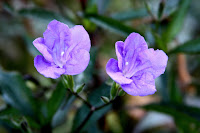Ruellia - Mexican Petunia - Fall Flowers!
 |
| Ruellia, Tall purple Mexican Petunia |
One of the flowers blooming now is Mexican Petunia.
While the two-to-three foot tall variety with lavender-purple blooms is the one
we commonly see, there are several others in the Ruellia family that are native
to the US.
Ruellia seeds are easy to start, and, a few years
after they are successfully started they will form small colonies of plants,
adding cheerful color to fall flower beds and feeding migrating butterflies and
skippers. Ruellias are free of insect and disease problems
The seed-grown plants in our garden came from AZ where
seedlings come up even when it is 115-degrees F.
If you are building a butterfly habitat, Ruellias
are important not only as reliable fall nectar for adult butterflies but also
as caterpillar food for several butterflies and moths. One of them, the Common
Buckeye, is a beautiful and unique sight with several large false eyes on the
wings. The caterpillars are black, white and orange with soft black spikes.
There are several Ruellia varieties, heights and
flower colors. Ruellia plants found for sale in garden centers vary so check
the tag for cold hardiness. The heights
range from 10-inches to 3-feet tall and the petunia-shaped flowers vary from
white-pink and deep pink to lavender and purple.
 |
| Ruellia, dwarf pink Mexican Petunia |
Ruellia caroliniensis or Carolina wild petunia, Ruellia drummondiana
or Drummond's wild petunia, Ruellia humilis or fringeleaf wild
petunia, Ruellia nudiflora or violet
wild petunia, Ruellia parryi or Parry's wild petunia, and
Ruellia strepens or limestone wild petunia.
Garden catalogs that refer to Ruellia spp, meaning
species, are offering Ruellia caroliniensis wild petunia seeds or plants.
Ruellia caerulea Morong Britton's wild petunia, has pink
flowers and grows in all the southern states but was planted there.
Those are not the most common varieties sold,
however. The one that is written about most often and sold widely is Mexican
petunia Purple Showers, Ruellia brittoniana.
Purple showers spreads by underground stolon rather than by seed. In FL
where growing conditions are ideal for it, Purple Showers is considered to be
invasive.
Missouri Botanical Garden named
Ruellia simplex Purple Showers one of their Plant of Merit
selections, mentioning its durability in wet or dry, sun or shade. They list
its hardiness as zones 8 to 10 but point out that with protection it will grow
as a perennial in zone 7.
Mexican Petunia brittoniana was named a Texas
Superstar plant by Texas A&M University because it tolerate wet or dry
soil, thrive in full sun but tolerates part shade.
In addition, plant breeders have introduced several
dwarf varieties in recent years.
The smaller dwarf Katie or Nolan’s dwarf is small
enough for the front of a border. The clumps grow about 10-inches tall and the
flowers are pink, white or purple.
Although dwarf Katie plants can grow in hot, dry
locations, they are said to be hardy only in zones 8-11. Our dwarf plants have
returned for four years so far.
Pink dwarf brittoniana Bonita, hardy in zones 8 to
10, would either be an annual or have to be protected during freezing
temperatures. Ruellia elegans Ragin Cajun, has flowers the color of red
peppers, is slightly taller, and cold hardy in zones 8-10.
Mexican petunia can be shared by digging up rhizomes,
by collecting seeds and by rooting cuttings in water, depending on the variety.
Prairie Moon Nursery (www.prairiemoon.com)
and Jellito Seed (www.jelitto.com) offer lavender flowering Ruellia humilis
seeds. Hardy in zones 4 to 9, R. humilis matures at 12-inches tall. Plant
Delights (http://www.plantdelights.com/)
offers six Ruellia varieties.
Ruellias were named for Jean de la Ruelle, herbalist
and physician to Francois I, King of France in the 16th Century.



Comments